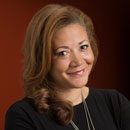This session is part of the five-week study group series, How Shifts in Race and Cultural Identity Influence Politics, Policy and Pop Culture, led by Michele Norris. Seminars are for Harvard students only (graduate and undergraduate), and are not-for-credit. Please register below to reserve your space.
Description: What this six-word essay from The Race Card Project hints at is a certain kind of status that comes from being part of a cohort that is considered “The Norm.” The word flesh actually refers to soft tissue in the body but over time it came to be a shorthand for skin color. In particular, skin color of a very particular hue. But as America’s demographics change and darken over time, does that also alter the commercial definition of “Mainstream America?” How are companies, institutions or political parties, or media outlets thinking about reaching an increasingly diverse American audience? For years, the “All-American” moniker has been a shorthand for a certain aesthetic or a mindset reflected in images such as baseball, white picket fences and apple pie. The Merriam Webster Dictionary defines the adjective “All American” as a wholesome descriptor for someone or something that has “qualities that are thought to be typical of people in the U.S.” But, what’s considered typical in a country that is becoming ever more diverse?
Time: Monday, March 9, 2015 – 6:00-7:30 p.m.
Location: Harvard Kennedy School, Taubman Building Room 102, Women and Public Policy Program Cason Conference Room
Suggested Reading
Defining American Identity in the 21st Century – This study surveyed 2,800 respondents across all racial lines to define “American.” The study posits that a multicultural America will widen the constitutive norms that define American because of the multiple traditions embraced by different cohorts.
The Changing Geographic nature of White America – The number of cities where the population exceeds 98% White is rapidly decreasing. There’s an interactive map here that illustrates the demographic change. There’s also a video that gives an overview of the changing US demographics, spanning from multiracial marriage, the age distribution of POC, and effects on elections.
Is Richard Sherman the new, True All American – Eric Liu, author and Seattle resident, asks this question following the infamous post-game interview where Sherman’s trash-talk stirred up a storm of discomfort.
Eric Liu’s book A Chinaman’s Chance is also a rich exploration of identity across two continents. Eric Liu’s website.
“The End of White America ?” – This was the headline that appeared atop a story in The Atlantic Magazine in January of 2009. President Barack Obama was about to take office and the magazine wanted to explore the question of whiteness as the touchstone of what it meant to be American. They wanted to know what the new mainstream would look like and they wanted to understand what it might mean to be white, when whites no longer constituted a majority and whiteness was no longer “the norm.” The editors kicked around several headlines and settled on the one you see here. The editor in chief at the time said the question mark was the most important thing in that headline in part because it took the edge off the words before it. But also, the question mark also symbolized the uncertainty about this new social frontier. This piece, written and reported by Hua Hsu, is now five years old but remains relevant.
“‘All-American Muslim’ TV show ends as viewership slumps” – What Happens when a TV network rolls out a series called “All American Muslim”? One could do an entire case study on the TLC Network’s experience rolling out a television reality show/docu-series about the lives of five Muslim families in Dearborn, Michigan in 2011. The show had good press and decent ratings but it was soon surrounded by controversy. A conservative Florida group charged that the show was little more “than propaganda that riskily hides the Islamic agenda’s clear and present danger to American liberties and traditional values.” Large retailers like Lowes pulled their ads. Celebrities and large religious groups called for boycotts of the retailers who pulled ads from the show. While Scandal sometimes translates into ratings gold in cable television, this was not the case for AAM. The show did not return for a second season. This may seem like yet another trivial chapter in television’s current obsession with reality TV. But in reality, there is an interesting intersection between the power centers in entertainment and government. While this drama played out behind the scenes in teak-paneled Hollywood board rooms, it was closely watched by politicians and policy makers in Michigan, Washington DC and beyond because of the sensitive questions around the portrayal, discussion or inclusion of Muslim Americans in a post 9/11 world.
“The Struggle Over Who is ‘American’” – Anand Giridharadas writes the “Letter From America” column for The New York Times. On March 3 in used his column to ask an interesting question—what does it mean to be a genuine American? Giridharadas often explores the changing nature of America in his column. He is also the author of a book called The True American: Murder and Mercy in Texas that grew out of his reporting. The book looks at what it means to be genuinely or at least ambitiously American from two very different vantage points.
Who Are We? The Challenges to America’s National Identity – by Samuel P. Huntington, the late conservative political scientist. He argues that countries made up of different cultures are in danger of coming apart. Multiculturalism, diversity, and bilingualism in the U.S. are strengthening the racial/ethnic identity at the expense of an overarching national identity or American Creed. “Historically the substance of American identity has involved four key components: race, ethnicity, culture (most notably language and religion), and ideology,” he writes. ”The racial and ethnic Americas are no more. Cultural America is under siege.”


